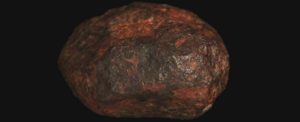
Wedderburn meteorite
Scientists have discovered a new mineral, one never before seen in nature, lodged inside a meteorite found near Wedderburn in central Victoria.
They believe that the mineral was probably forged in an ancient planet’s molten core, long since destroyed.
The meteorite from its million-year-plus journey is red and black and deeply scarred, and certainly looks like the part. Edscottite has been christened the mineral it includes.
After close examination of the Wedderburn Meteorite, a lemon-sized chunk of metal found just outside Wedderburn in 1951, the mineral was found and is now part of the collection of Museums Victoria.
It was discovered in a distant Australian gold rush city on the side of a highway. Wedderburn was a hotspot for prospectors in the ancient days–it’s still ##lies–but no one ever saw a nugget like this.
The Wedderburn meteorite, discovered in 1951 just north-east of the city, was a tiny 210-gram piece of strange-looking space rock falling from the heavens. Scientists have tried to decipher their secrets for centuries, and researchers have just decoded another.
Scientists analyzed the Wedderburn meteorite and checked the first natural appearance of what they call’ edscottite’ in a fresh research conducted by Caltech mineralogist Chi Ma: a unusual type of iron-carbide mineral that has never been discovered in existence.
Since the spatial origins of the Wedderburn meteorite were first identified, numerous research teams have examined the distinctive black-and-red rock–to the extent that only about one-third of the original specimen remains intact, held in Australia’s Museums Victoria Geological Collection.
In a sequence of pieces, the remainder were removed to analyze what the meteorite is made of. These analyzes disclosed gold and iron traces along with rarer minerals such as kamacite, schreibersite, taenite, and troilite. Now edscottite can be added to that list.
The finding of edscottite–named in honor of the University of Hawaii’s meteorite specialist and cosmochemist Edward Scott–is important because we have never before verified that this separate nuclear formulation of iron carbide mineral happens naturally.
Such a confirmation is important as it is a prerequisite for the International Mineralogical Association (IMA) to formally recognize minerals as such.
For centuries, a synthesized form of the mineral iron carbide has been considered –a stage generated during metal smelting.
But thanks to Chi Ma and UCLA’s new analysis of geophysicist Alan Rubin, edscottite is now an official member of the mineral club of the IMA, which is more exclusive than you might believe.
“We found 500,000 to 600,000 minerals in the laboratory, but less than 6,000 that nature itself did,” Museums Victoria senior geoscience curator Stuart Mills, who was not involved in the new study, told The Age.
As for how this sliver of natural edscottite ended up just outside rural Wedderburn can’t be known for sure, but according to planetary scientist Geoffrey Bonning from Australian National University, who wasn’t engaged in the research, the mineral could have developed in an ancestral planet’s warm, pressurized heart.
Bonning informed The Age that this ill-fated, edscottite-producing planet might have endured some sort of huge cosmic crash–involving another planet, or a moon, or an object–and was torn apart, with the fractured pieces of this demolished globe flowing through moment and space.
Millions of years ago, thought continues, one such piece lands just outside Wedderburn by opportunity–and for it, our knowledge of the Universe is the richest.
Reference:
Edscottite, Fe5C2, a new iron carbide mineral from the Ni-rich Wedderburn IAB iron meteorite. DOI: 10.2138/am-2019-7102










